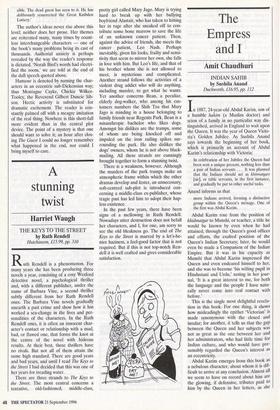A stunning twist
Harriet Waugh
THE KEYS TO THE STREET by Ruth Rendell Hutchinson, £15.99, pp. 310
Ruth Rendell is a phenomenon. For many years she has been producing three novels a year, consisting of a cosy Wexford detective novel, a psychological thriller and, with a different publisher, under the name of Barbara Vine, a second thriller subtly different from her Ruth Rendell ones. The Barbara Vine novels gradually unearth a past crime and show how it has worked a sea-change in the lives and per- sonalities of the characters. In the Ruth Rendell ones, it is often an innocent char- acter's contact or relationship with a mad, bad, or flawed one, that forms the knot at the centre of the novel with hideous results. At their best, these thrillers have no rivals. But not all of them attain the same high standard. There are good years and bad years, and until I read The Keys to the Street I had decided that this was one of her years for treading water.
There are three strands to The Keys to the Street. The most central concerns a tentative, old-fashioned, middle-class, pretty girl called Mary Jago. Mary is trying hard to break up with her bullying boyfriend Alastair, who has taken to hitting her in rage after she sneaked off to con- tribute some bone marrow to save the life of an unknown cancer patient. Then, against the advice of friends, she meets the cancer patient, Leo Nash. Perhaps inevitably, given his looks, frailty and sensi- tivity that seem to mirror her own, she falls in love with him. But Leo's life, and that of his brother whom she is not allowed to meet, is mysterious and complicated. Another strand follows the activities of a violent drug addict who will do anything, including murder, to get what he wants. Yet another concerns Bean, a peculiar, elderly dog-walker, who among his cus- tomers numbers the Shih Tzu that Mary Jago is minding in a house belonging to family friends near Regents Park. Bean is a misanthropic bachelor who likes dogs. Amongst his dislikes are the tramps, some of whom are being knocked off and impaled on the iron railing spikes sur- rounding the park. He also dislikes the dogs' owners, whom he is not above black- mailing. All these strands are cunningly brought together to form a stunning twist.
There is a weakness, however. Although the murders of the park tramps make an atmospheric frame within which the other dramas develop and fester, an unnecessary, soft-centred sub-plot is introduced con- cerning a middle-class ex-publisher, whose tragic past has led him to adopt their hap- less existence.
In the past few years, there have been signs of a mellowing in Ruth Rendell. Nowadays utter destruction does not befall her characters, and I, for one, am sorry to see the old bleakness go. The end of The Keys to the Street is marred by a let's-be- nice haziness, a feel-good factor that is not required. But if this is not top-notch Ren- dell it is well crafted and gives considerable satisfaction.


















































































 Previous page
Previous page